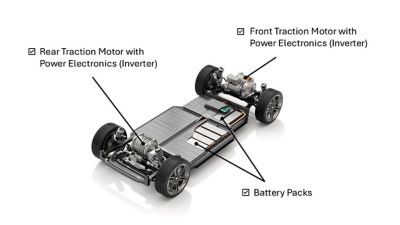-
United States -
United Kingdom -
India -
France -
Deutschland -
Italia -
日本 -
대한민국 -
中国 -
台灣
-
Ansysは、シミュレーションエンジニアリングソフトウェアを学生に無償で提供することで、未来を拓く学生たちの助けとなることを目指しています。
-
Ansysは、シミュレーションエンジニアリングソフトウェアを学生に無償で提供することで、未来を拓く学生たちの助けとなることを目指しています。
-
Ansysは、シミュレーションエンジニアリングソフトウェアを学生に無償で提供することで、未来を拓く学生たちの助けとなることを目指しています。
トピックの詳細
EVパワートレインとは
電気自動車(EV)は、電気をエネルギー源として動く自動車です。電力は、一般的にはバッテリ(BEV)または燃料電池(FCEV)から供給されます。EVパワートレインは、電気自動車に搭載された、電気エネルギーを機械的な動きに変換するシステムです。
EVパワートレインは以下で構成されています。
- エネルギー貯蔵システム — バッテリまたは燃料電池
- パワーエレクトロニクス — インバータ/コンバータおよび関連するコントロール機能
- 電動機 — エネルギー変換システム(電動モータ)
- 機械システム — トランスミッションシステム
EVドライブトレインには、ドライブシャフトとその機械部品も含まれます。また、EVパワートレインは作動中に排気ガスを発生させないため、電気自動車は、より環境に優しい輸送手段となります。
パワートレインとは
パワートレインとは、車両を駆動するための動力を発生させて制御する、車両内の一連のコンポーネントです。
バッテリ式電気自動車(BEV)は、電気自動車の標準になりつつあります。BEVは、よりシンプルな設計でメンテナンスコストが低いことから、2023年には世界中の電気自動車の70%、2022年に販売された小型商用電気自動車の98%を占めています。
BEVパワートレインには、電気エネルギーを貯蔵するためのバッテリパック、電動モータを駆動するための電力変換用のインバータ、電気エネルギーを機械的な動きに変換する電動モータ(原動機)、モータからホイールへの出力を制御するギアボックスが組み込まれています。
EVパワートレインは、エンジン、燃料噴射システム、排気システムを必要とする内燃エンジン(ICE)とはアーキテクチャが大きく異なり、テールパイプからの排気ガスやICEノイズがありません。可動部品が少ないため、摩耗が少なく、頻繁なメンテナンスが必要となる点火プラグなどの部品やオイル交換が不要になるため、維持費も低くなります。

EVパワートレインの主要コンポーネント
持続可能な未来を目指すさまざまな取り組みが進む中、電気自動車の利点が広く知られるようになりました。電気自動車の主要コンポーネントはバッテリですが、さまざまなパワーエレクトロニクスコンポーネントが連動して電力の流れを制御および調整しています。
実際に、パワーエレクトロニクスはEVパワートレインシステムの重要な部分を担っており、エネルギー変換を最適化し、電気自動車の最適な動作、安全性、性能を確保します。
EVパワートレインの発電システム
発電システムは、車両を動かすために必要な電力を供給します。
バッテリパック: バッテリパックには、一次エネルギー貯蔵メカニズムとして機能する多数の電池(通常はリチウムイオン電池)が組み込まれています。リチウムイオン電池はエネルギー密度が高く、単位体積あたりで非常に大量のエネルギーを貯蔵できます。燃料電池も、エネルギー貯蔵方法の1つです。
バッテリパックにはバッテリ管理システム(BMS)も組み込まれており、バッテリの安全な動作を保証するために過充電または放電を防止する機能を備えています。
車載用充電装置: 外部充電源(電力グリッド)からの交流電流(AC)を直流電流(DC)に変換してバッテリに電力を貯蔵する装置です。車載用充電装置は、車両制御ユニットや外部充電ステーションとの通信を介して電力供給を調整します。また、サイバーセキュリティ機能を備えることもあります。
EVパワートレインの電源供給システム
電源供給システムは、電源からの電力を制御します。バッテリからのDC電力をモータで使用するAC電力に変換するインバータなど、パワーエレクトロニクスコンポーネントが組み込まれています。パワーエレクトロニクスのさまざまな制御トポロジーにより、効率を高めたり、最大トルクを達成したりするための、さまざまなインバータスイッチング方法を提供することで、性能の向上にもつながります。
DC-ACインバータ(トラクションインバータ): DC-ACインバータは、バッテリからのDC電力をAC電力に変換し、モータの速度と加速を制御するために必要な交流電圧を生成します。DC-ACインバータには、絶縁ゲートバイポーラトランジスタ(IGBT)またはシリコンカーバイド金属酸化膜半導体電界効果トランジスタ(SiC MOSFET)パワーデバイスが組み込まれており、それらは多数のプリント回路基板(PCB)やバスバーで接続されています。これらのパワー半導体デバイスは、電動モータへの高レベルの電流や電圧をオン/オフする高速スイッチとして振る舞うことで、正弦波電流を流します。
DC-DCコンバータ: DC-DCコンバータは、バッテリの高電圧DC出力を調整して、照明、エンターテインメントシステム、エアコンといった補助システムに電力を送るための低電圧DCを供給します。DC-DCコンバータには、パワー半導体、ダイオード、コンデンサ、磁気などのパワーエレクトロニクスが組み込まれています。DC-DCコンバータは、充電装置とジャンクションボックスを含む電源モジュール(PDM)に組み込むこともできます。
車両制御ユニット: 車両制御ユニットは、EVの中心的な通信ハブであり、さまざまなシステム、センサー、コントローラからデータを収集して処理します。車載用充電装置、バッテリ、モータ、その他のシステム間でのアクティビティを同期します。
電源供給ユニット: 電源供給ユニットは、車両の各システムが適切な量の電力を受け取るようにする装置です。スイッチ、ヒューズ、リレー、そして場合によっては半導体デバイスなどのパワーエレクトロニクスが組み込まれており、システムの過負荷を防ぎ、効率的な動作を可能にします。
ファームウェアとECU: EVパワートレインコンポーネントの効率的で安全な動作は、ファームウェアによって駆動される一連の電子制御ユニット(ECU)により調整され、効率的なデータ交換と処理を保証します。
熱マネジメントシステム: 熱マネジメントシステムは、バッテリとモータを極端な高温から保護し、EVの駆動システムとエコシステム全体で効率的かつ安全なプロセスを保証します。
EVパワートレインにおける電気-機械のエネルギー変換
トラクションモータ: トラクションモータは、路面との摩擦を生じさせ、車両を前進させる主要コンポーネントです。通常は、以下のもので構成されます。
- ステータ: モータの静止部分。ステータの円周上に等間隔で配置されたスロットに銅コイルが巻かれた透磁性鋼板で構成されています。
- ロータ: モータの回転部分。一般的に、ステータ設計との最適な相互作用によってトルクを発生させるように配置された永久磁石と透磁性鋼板で構成されています。ただし、永久磁石の代わりにかご構造を採用した「かご形誘導モータ」を使用するなど、トルクの生成に磁石を必要としないモータトポロジーもあります。
電流がステータのコイルを通過すると、回転磁場が発生します。この磁場はロータの磁石(または誘導モータのかご)と相互作用し、これによってロータが回転して、動きが生じます。EVのアクセルペダルは、制御システムやパワーエレクトロニクスを介してバッテリからモータに流れる電力の量と周波数を制御し、モータで生成されるトルクを制御します。
多くのEVには、ACモータ(ブラシレス永久磁石モータのような同期機または誘導モータのような非同期機)が搭載されています。
ギアボックスとトランスミッション: ICE車両と同様に、エンジンやモータの出力をホイールで必要な出力に一致させるために、機械伝動装置が必要になります。EVのギアボックスは、通常はICE車両のギアボックスよりもはるかに単純です。電動モータが燃焼エンジンよりもはるかに広い速度範囲にわたってトルクを生成でき、ゼロ速度でのトルク生成も可能であるためです。つまり、ICEのトランスミッションで一般的に採用されるクラッチや広いギアレンジが不要になります。ただし、電動モータは、ホイールにおいて必要な速度よりも高い速度で回転するように設計されているため、ギアボックスを使用して速度を低下させ、発生トルクを増加させます。
電気自動車のトランスミッションの多くは、単一の固定ギア比に設定されているため、ギア比を変更するためのコンポーネントは必要ありません。マルチスピードギアボックスは、高性能EVや大型商用EVでトルクと速度のレンジを拡張するのに役立ちます。
HEVパワートレインでは、従来型のギアセットまたは遊星ギアセットを使用して、1つまたは複数のモータとエンジンからのパワーを組み合わせる際に、ギアボックスが重要な役割を果たします。走行条件に応じて、このギアボックスはモータやエンジンと連携して最も効率的な方法で電力を供給します(たとえば、内燃エンジンが作動していない状態で車両を操作したり、走行条件が適している場合にエンジンとモータを発電モードで使用してバッテリを充電したりする)。
差動装置は、通常は電気自動車のギアボックスに組み込むか、パワートレインレイアウトによっては独立したコンポーネントにすることもできます。
電動パワートレインのタイプ
電動パワートレインには、構成や機能の違いに基づいて主に3つのタイプがあり、さまざまなニーズと好みに対応しています。
バッテリ式電気自動車(BEV): 「純粋な電気自動車」とも呼ばれるBEVは、再充電可能なバッテリパックに蓄えられたエネルギーからすべての電力を得ます。燃料タンクなどの二次エネルギー貯蔵源は使用しません。
BEVは外部電源から充電する必要があり、最新型車両の航続距離は100~400マイル(約160~640km)です。ハイエンドEVでは、航続距離がさらに長くなることもあります。BEVの例としては、Tesla Model 3、日産リーフ、BMW i3などがあり、多くの新型モデルが市場に登場しています。
ハイブリッド電気自動車(HEV): HEVは、内燃エンジンと電動ドライブトレインを組み合わせた電気自動車で、従来のICE車と比較して燃費と性能が向上しています。
HEVの場合、動力源として使用する電気量は車両によって異なります。ハイブリッド電気自動車には、以下のようなメリットをもたらす機能が組み込まれています。
- 運動エネルギーを電気エネルギーに変換してバッテリに蓄える回生ブレーキ(BEVも同様)
- アイドリング時にエンジンを停止して、排気ガスを削減するスタート/ストップシステム
- バッテリを再充電する、または電動モータに追加電力を供給する発電機(ICEから電源供給される)
最新型HEVの航続距離は400~600マイル(約640~960km)です。PHEVを除き、HEVは通常、外部電源から充電されません。HEVの例としては、Ford Fusion Hybrid、トヨタ自動車のカムリハイブリッド、Hondaのシビックハイブリッドがあります。
プラグインハイブリッド電気自動車(PHEV): PHEVは、HEVのサブクラスであり、外部電源から充電できます。電気のみで20~50マイル(30~80km)の航続距離を達成できるため、短距離の走行に適しています。PHEVでより長い航続距離を達成するには、ガソリンやディーゼルを使用する必要があります。PHEVの例としては、トヨタ自動車のプリウスプライム、Chevrolet Volt、Hondaのクラリティがあります。
燃料電池電気自動車(FCEV)は、電気自動車の4つ目のタイプです。バッテリの代わりに水素燃料電池から発生させた電流を動力として利用します。
ICEとEVのパワートレインの比較
内燃エンジンは、これまで1世紀以上にわたって自動車の主要動力源として採用されてきました。
しかし、ICEが採用されてきたことで、化石燃料の燃焼による環境汚染をはじめとする、複数の問題も生じてきました。そうした問題を解決するために、世界各国で電気自動車への転換に向けた取り組みが進んでおり、消費者の関心も高まっています。
ICEとEVのパワートレインの主な違いを以下に示します。
重要な要素 | ICE車両 | 電気自動車 |
パワートレイン | エンジン、マルチスピードトランスミッション、燃料システム、排気システムを含む | バッテリ、インバータおよびコントロール、電動モータ、トランスミッションで構成される |
原動機 | 内燃エンジン | 電動モータ |
エネルギー源 | 化石燃料 | バッテリ、燃料電池 |
25~36% | 80~85% | |
環境への影響 | 温室効果ガスの排出 | テールパイプからの排気ガスがゼロまたは(HEVの場合)排気ガス削減による環境への影響の低減 |
EVパワートレインの利点
EVパワートレインの利点は、運転習慣や好み、さらには充電ステーションへの距離などによって異なりますが、主な利点は次のとおりです。
- 排出量ゼロ: 公害や温室効果ガスの削減という観点では、BEVパワートレインの最大の利点は、化石燃料の燃焼によるテールパイプからの排気ガスがなく、BEVの寿命全体で二酸化炭素排出量が削減されることです。
- 騒音公害の軽減: BEVパワートレインは、温室効果ガスの排出がないことに加えて、騒音も少なく、より静かな走行が可能です。
- エネルギー効率: BEVパワートレインは、ICEパワートレインよりも大幅にエネルギー効率が高く、貯蔵されたエネルギーの80%以上をパワーに変換します。また、回生ブレーキなどの機能により、エネルギーのリサイクルが可能です。
- メンテナンスコストの削減: 可動部品が少ないため、メンテナンスコストが削減され、最適な条件と適切なケアを行えば、バッテリの寿命は最長12年にも及びます。ただし、他のバッテリと同様、時間経過に伴ってバッテリの容量は減少していきます。
- 燃料コストの削減: BEVに電力を供給するための電力コストは、一般的にはICE車両のガソリンやディーゼルのコストよりも低くなります。ミシガン大学が実施した調査によると、米国ではEVの電力コストと比較して、ガソリン車への給油コストが2倍以上になることが明らかになっています。
- 総所有コスト(TCO)の削減: 一般的に、BEVは先行購入コストが高くなりますが、燃料とメンテナンスの節約によってTCOが削減されるため、車両の寿命全体での運用コストは低くなります。
EVパワートレインの欠点
EVパワートレインには、以下のような欠点もあります。
- コスト: 現状では、パワートレインコンポーネント(主にバッテリ)のコストが高いため、電気自動車の方がICE車両よりも多くの先行投資を必要とします。
- 充電時間: ICE車両の燃料タンクは数分で満たすことができますが、EV用バッテリの充電時間は、充電ステーションの充電容量に応じて30分から数時間かかります。
- 消費者が抱く懸念: 現在、1回の充電でのBEVの航続距離はそれほど長くありません。充電ステーションはガソリンスタンドほど普及しておらず、バッテリの充電には時間を要するため、BEVで長距離を走行することに不安を感じる消費者もいます。
EVパワートレインの設計
EVパワートレインの設計は、主に効率的な熱マネジメントと航続距離の向上を目指しています。出力密度(単位体積あたりの電力供給量)の向上が求められているため、発電量と熱放散で慎重にバランスをとることが必要です。EVの燃費、効率、および全体的な性能は、コンポーネント、システム、およびアーキテクチャレベルで最適化できます。
たとえば、走行モードを駆動システムに組み込むことで車両性能が大幅に向上し、走行条件に基づいて複数の構成が可能になります。
ハードウェアアーキテクチャに組み込まれたECUは、拡張機能を提供します。たとえば、0~60mphの加速といった特定の要件を満たし、エネルギー消費量を最適化するために、ドライバーからのスロットル指示をモータやバッテリへの指示に変換する機能などが提供されます。これらのECUは、ダイナミックプログラミングや消費削減のためのアルゴリズムによって駆動されます。
これからのEVパワートレイン
電動化が推進される中、EVパワートレインは効率性、環境への配慮、性能の向上をもたらすことが期待される大きなイノベーションです。EVへの移行が進むにつれ、SUVや高級車からトラックまで、さまざまなモデルが市場に登場することでしょう。
Ansysは、この技術改革の最前線に立ち、可能な限り最良の方法でエネルギーを消費する、クリーンなテクノロジーソリューションへの変革に取り組んでいます。
Ansys ConceptEV®は、EVパワートレインシステム全体の性能を向上させるための設計およびシミュレーションプラットフォームです。このプラットフォームにより、エンジニアリングチームは部門を横断してコンポーネントモデルを接続し、車両レベルの要件を評価できるようになります。その結果、以下を含め、開発プロセス全体を通して迅速かつ正確な意思決定が可能になります。
- 詳細度の異なるコンポーネントモデル
- 組込み制御アルゴリズム
- コンポーネント設計ツールとの統合
- パワートレイン機能のシミュレーション
- システムトレードオフの定量化
目標コストを達成しながらエネルギー効率に優れたパワートレインを開発するために役立つAnsys ConceptEVを無料でお試しいただけます。また、ConceptEVを導入して電気自動車のパワートレインの効率と性能をどのように向上させるかについては、こちらのデモをご覧ください。
関連リソース
さあ、始めましょう
エンジニアリング課題に直面している場合は、当社のチームが支援します。豊富な経験と革新へのコミットメントを持つ当社に、ぜひご連絡ください。協力して、エンジニアリングの障害を成長と成功の機会に変えましょう。ぜひ今すぐお問い合わせください。










